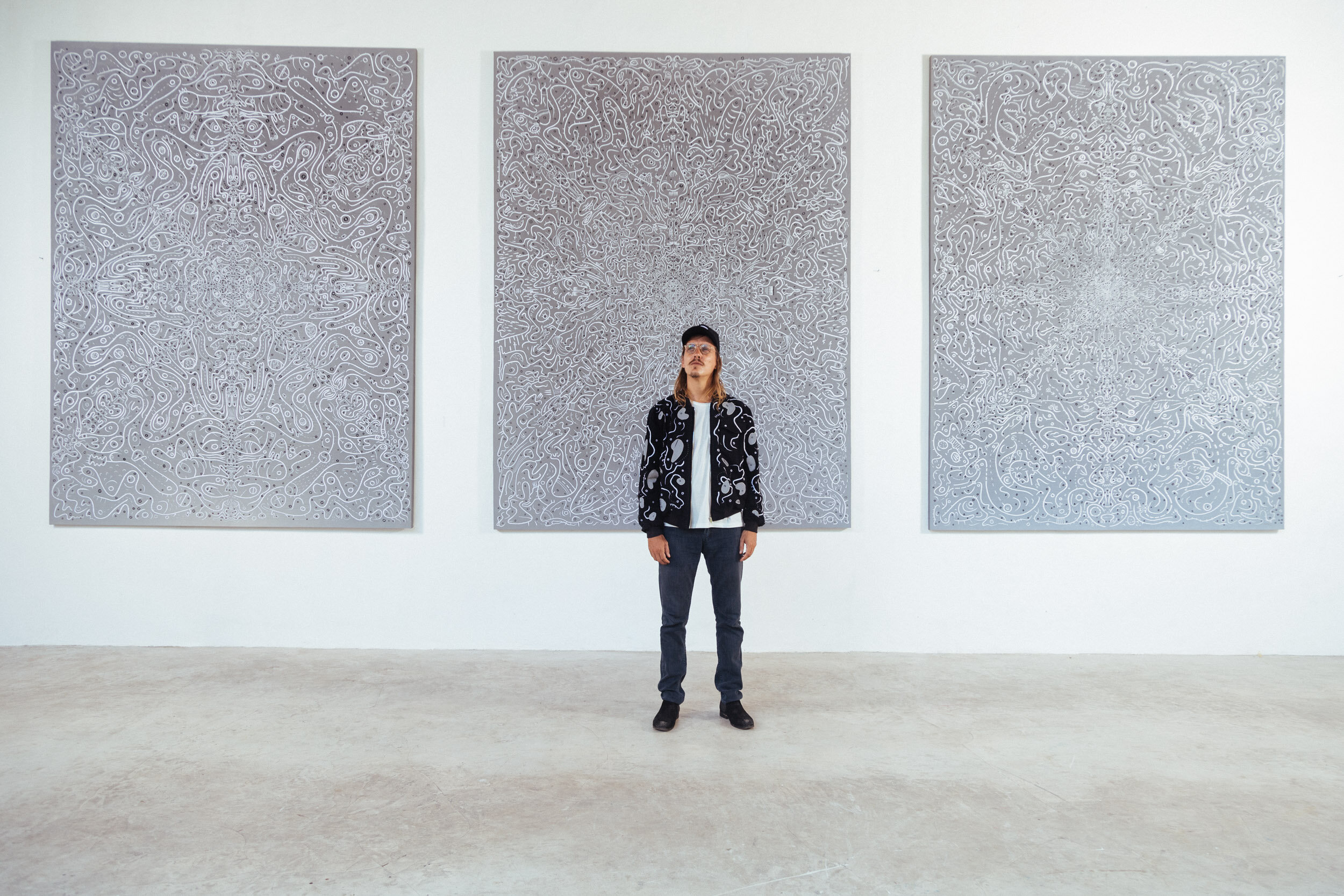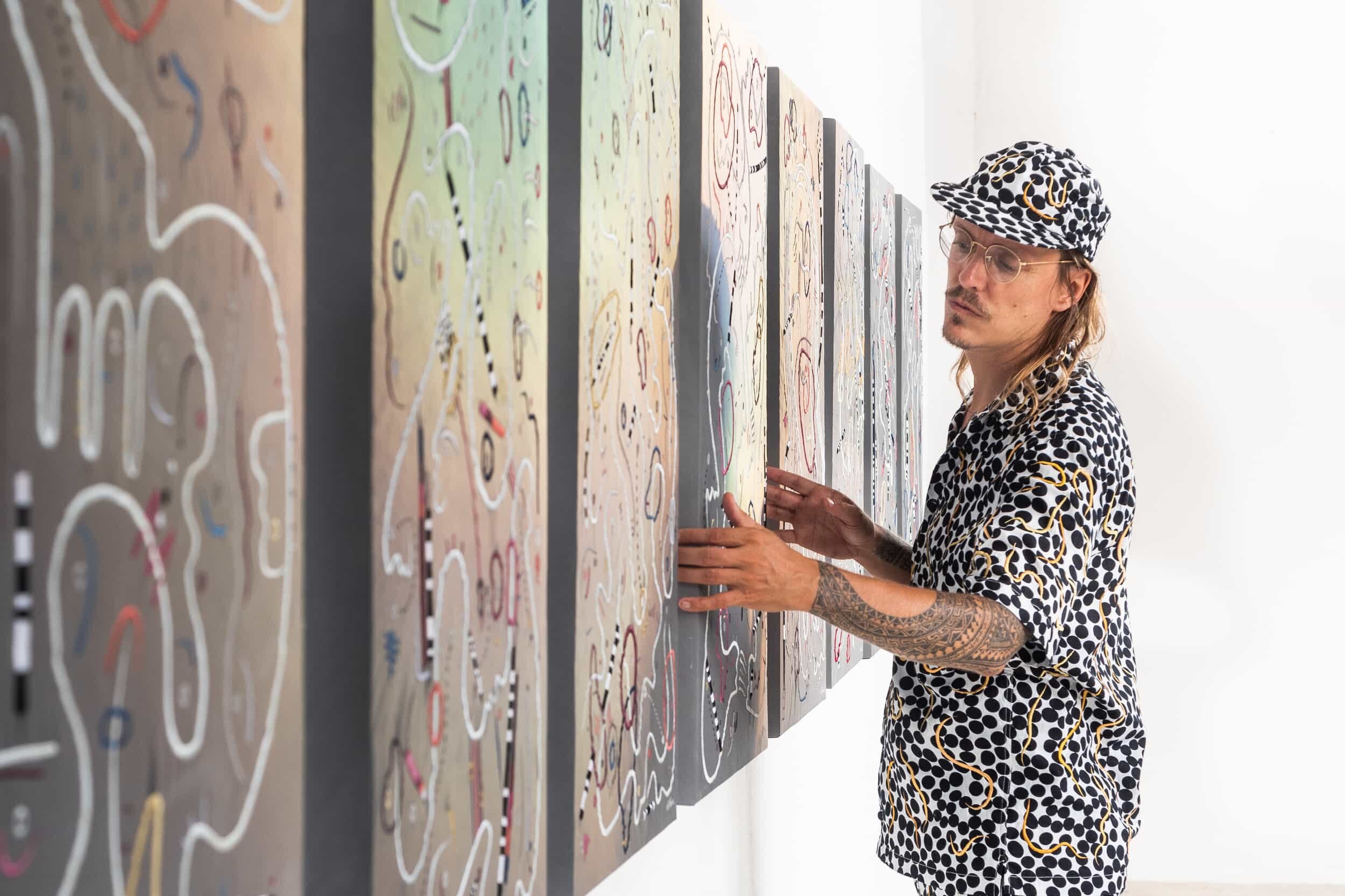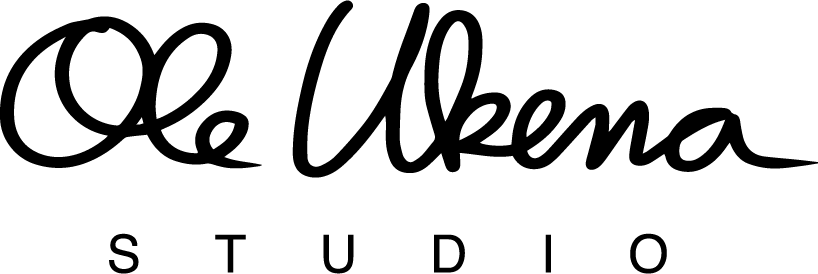
ABOUT Ole Ukena
Meet Ole
Ole Ukena is a German multidisciplinary artist that lives and works in Berlin, Bali, and Brazil. Ukena interweaves a variety of media including sculpture, installation, watercolor, drawing, text, photography & video, and has in recent years focused on working with textiles. Ukena is known to merge traditional embroidery processes in combination with high-tech reflective and uncommon materials. Ukena refers to his textile work simply as “paintings”. His recent work is typically situated in a place between abstraction and figuration and his intuitive lines create dream-like associations that open the narrative for the viewer to complete.
Since 2020 his body of work has extended to architecture, murals, as well as wearable pieces, taking the work out from the gallery and studio context into the streets. His work has been shown in galleries and museums around the world including Centre Pompidou, Paris (2011), Paris Photo, Grand Palais (2013), Giving Up Is Not An Option, Serindia Gallery Bangkok (2011), Highjacking Karma, Stigter Van Doesburg, Amsterdam (2015), Galeria Lume, Sao Paulo (2018), Three And One Chairs, KMAC Museum, Louisville (2019).
WANT A QUICK INTRO?
Hi, there. Not sure if you wanna spend more time here with me? Then have a quick jump into MY WORLD AND WATCH this 3-minute video. IT´S ALL IN THERE.

“What I see is not as important to what you feel and imagine when you look at a piece. In fact, I want you to completely forget what you think I see and approach the piece as if your own subconscious mind sends you a message and it’s up to you to give it meaning.” - Ole Ukena
STILL WANT TO KNOW MORE?
A FEW SELECTED INTERVIEWS COULD HELP.

INTERVIEW #1
A bit about my upbringing, why I moved into textiles, and why you should not call yourself an emerging textile artist.
GERMAN ARTIST OLE UKENA IS BASED IN BALI. AFTER MOVING THERE HE FELT THE NEED TO WORK WITH TEXTILES AND HASN’T STOPPED SINCE. HE USES A RANGE OF TECHNIQUES INCLUDING HAND AND MACHINE EMBROIDERY, QUILTING, AND WEAVING DEPENDING ON THE PIECE AND HAS EXHIBITED WORLDWIDE INCLUDING THE CENTRE POMPIDOU.
“I CREATE WORKS THAT ARE LOCATED IN THE IN-BETWEEN SPACE OF ABSTRACTION AND FIGURATION EXPLORING HIDDEN TALES FROM THE MICRO AND MACROCOSM.”
Firstly where did you grow up and where do you live now?
I grew up in Germany and spent most of my time in Berlin. It’s a weird and unique place for Germany as it feels very unGerman in a way. I literally didn’t have any friends with regular jobs, but everyone around me was doing something creative. Berlin attracted all the misfits and weirdos since you didn’t have to do military service if you lived there. When combined with the collapse of eastern Germany, very low rents and lots of empty space it created a very fertile ground for artists and different lifestyles from the German mainstream. I personally never really considered myself as very German. I have been living in Asia and South America for almost a decade now. I recently reconnected with my European roots more and more, and I miss the times not seen as a “foreigner” despite speaking the local language fluently. I have lived in various places around the world, including India, Thailand, and Brazil, but now for the last eight years, I call Bali my home, and it is also here where I built up my studio but who knows where I will end up in the future.
What is your background in art?
I studied fine arts at the University of Arts in Berlin and then also experimental media plus spend a good amount of my twenties in the field of documentary filmmaking. The UDK is Berlin’s most prominent Art University, but to be honest, I spend almost six months every winter semester elsewhere in warm places with excuses of shooting documentary films. I found out very early that I needed this to balance my life and that the academic climate almost killed my love for art. I figured out my own path then and haven’t really looked back ever since.
Why did you move into textile art?
It was a surprise even for me! I literally woke up one day in Bali and was like “I think I want to paint with textiles.” And I went to a local market and got myself my first sewing machine and hired a local lady to teach me how to use it. I worked as a conceptual artist with installations and sculptures, and photography for a decade and felt the urge to work more intuitively again. I actually wanted to paint, but painting felt like a room filled with so many dead painters in a historical art context; trying something like textile and embroidery work felt like an easier field to innovate and experiment. I also liked the idea that I had not many reference points around me and that it was a craft rather associated with women.
What techniques do you use?
I use a mixture of hand embroidery, freehand machine embroidery, quilting, cutting, dyeing, and weaving. I’m open to all traditional techniques that exist within the field of textiles, and I just don’t want to work with computers. From my background as a conceptual artist, where I was always looking at the metaphorical potential of a material, I learned to just say yes to all materials and processes if the work seems to need it.
How do you describe your work?
I create works that are located in the in-between space of abstraction and figurative exploring hidden tales from the micro and macrocosm. I don’t like to over articulate the story of a piece but keep it in this borderline space where the viewer is still engaged in creating its own narrative. A good piece will shift and change over time and stay interesting that way; I am increasingly getting into a way of working that’s close to my childhood years where I just get so absorbed in the process that everything else fades away and I awake from this dream state with a filled canvas. I used to talk a lot about the meaning behind my work. Recently, I prefer to leave this up to the viewer’s eye. Instead, I talk about WHAT PLACE I paint from and with what quality and how working from a flow state harvests the visual language from the collective as well as individual subconscious. I could talk a bit more about Jung and how he has influenced my work but then again I prefer for people to rather look and discover by themselves.
How do you create a piece?
I work very intuitively and usually start sketching with chalk directly on the fabric, and then I start layering with various rounds of embroidery and cutting out fabric. I work fast. And I usually work on various pieces simultaneously, so I move around a lot in the studio so quickly so I don’t enter the thinking mind so much. On a good day, I go to bed and I ask myself what the fuck just happened; on a bad day, I know where I will end up… and on a mediocre day, I will answer my emails and give interviews and update my website.
Why did you decide to settle in Bali?
It is a beautiful and magical island, and the tropics have always drawn me as I hate the winter and cold weather. Then it is also a very rich island in terms of craftsmanship, and I can learn about traditional techniques that are already forgotten in the other parts of the world. But in the end, it’s a love affair, and it’s hard to explain why you fall in love with a woman; or a place and you just feel it. I fell in love as soon as I arrived and knew I could live here and I think it has been one of the best decisions in my life.
I know this is a hard question but how long does a bigger piece take?
The largest pieces I create are 4-5 meters wide and take 600-800 hours and a lot of patience up to a point where you question your own sanity. I am also working on some crazy long-term pieces that will take more than 1000 hours. But I need to make smaller pieces in between as otherwise, you might need to pick me up from the mental hospital by the end of the month, and now, I also have a whole team that supports me as otherwise, the larger pieces would take me years to create. I need these quick and regular success stories to keep my patience for the bigger pieces.
What are you most proud of in your art career so far?
I am proud that I have created an amazing studio space with a team of 10 people that I love to spend time with every day, and that still feels like an absolute dream.
I love getting up and going to work. Also, I am proud that I made a jump from conceptual art and a way of working into a very new arena of textile art where I didn’t know anything yet and didn’t shy away to just keep doing what was working. When it comes to exhibitions, I´d say the museum shows in some bigger institutions stay in my mind as I am also a fan of these places like Centre Pompidou, and then I had work in there which felt just pretty surreal. But I am most proud that I am neither bitter nor jealous and have managed to keep my humility and optimism in this sometimes very harsh and academic climate and manage to make a pretty good living with something I really love and still feel enthusiasm for.
Do you have any advice for aspiring textile artists?
Don’t call yourself an aspiring textile artist but just an artist that happens to work with textiles. Aspire to stay curious and filled with wonder and find out where you feel this the most. Stay there and dedicate yourself fully and don’t listen to what society tells you if it leads to doubting your path. It is possible to make money from what you love. Don’t go in it for the fame; go and stay in it for the love of the work and experience.
Who knows what you will do tomorrow and where your work will push you. Also, stop comparing yourself with other artists as it steals valuable headspace and, most importantly, HAVE FUN, SURPRISE YOURSELF, keep a disciplined studio time and surround yourself with other creative creatures that support and inspire you.
Drink coffee, make a headstand to change your perspective, make the creation process just in between you and the universe and learn how to spend a good amount of the day in a flow state.
CLICK HERE TO READ THE WHOLE INTERVIEW @ TEXTILE CURATOR

INTERVIEW #2
A talk about LEGO, the role of the artist
AND WHY AND HOW i STARTED BUILDING ARTIST RESIDENCIES.
“Making space for other creatives is just an extension of the artistic practice. I see artist residencies as more of a social sculpture or long-term installation.”
What is the primary role of an artist in society? Tell us about your own personal evolution and your ongoing commitment to arts.
An artist’s role in society is a big question. At the very core, I see him as a magician who expresses what couldn’t be expressed in other ways. Artists are here to seduce, inspire, mirror, digest, predict, criticize. It depends on what kind of an artist you are, but all of us are bringing ideas into the material realm to say things we find meaningful. I evolved from a more conceptual approach to dedicating my days to spend as much time as possible in the flow state as my current works all work with this direct intuitive expression in which I am almost watching myself create the works without interfering.
I am open to all mediums. I’ve worked in sculpture, installation, photography, film and now I’m in a phase where I work mainly with textiles and making spaces for other creatives. It’s a daily practice and at the end of the day, it’s direct communication between me and the universe and other people can always join this conversation if they’d like to listen. The beauty about working so intuitively is that you look at the studio at the end of the day and are surprised and satisfied because you didn’t know what kind of plants would grow – all you knew was that you had to show up in the studio and water them. They will grow by themselves over time. That pretty much sums up my art-making process currently.
Take us to the beginning of your story. How did your tryst with art begin?
I’ve been drawing since I was a kid – first thing in the morning for hours. Then came Lego. Then building of tree houses. It kinda never stopped for me after that.
At twelve years old, I had a drawing up in my school in some kind of exhibition and a teacher liked it so much, he offered 50 Deutsche Mark to buy it. That’s the first time I understood that it’s actually possible to survive with making art. I remember buying enough chocolate for months, but I ate it in a week instead.
How do you describe yourself in the context of challenging people’s perspectives via your work?
I used to make more conceptual pieces with witty punchlines about the state of the world we live in or whenever I felt I understood something, but eventually, I got bored of knowing what the end result would look like.
Now I create much more from my intuition and let the viewer challenge their own process of making sense of it. When you look at the work, it always shifts – it’s still in the process of becoming and you will see and unsee many times.
What were your motivations for offering an artist-in-residence program? What is your expectation from the artists who participate?
Making space for other creatives is just an extension of the artistic practice. I see artist residencies as more of a social sculpture or long-term installation. You design the space and the framework where ideas and conversations happen. Plus you get to meet other creatives from around the world. What more can I ask for?
What inspires you? Take us through your frameworks and process.
I am inspired by cross-pollination. What happens when a musician sits down with a scientist and a photographer and they exchange ideas in a very down-to-earth manner? What happens here is a transfer of knowledge from one field to another which is pretty much how every creative innovation happens. In my own art practice, I find inspiration in music and shapes in nature and in dreams.
CLICK HERE TO READ THE WHOLE INTERVIEW @ ASIAN CURATOR

Allright. STILL HERE.
2 MORE VIDEOS?
In these two videos, I will give you the story behind two SPECIFIC pieces and how I end up with names such as “VIVID MEMORY OF A DRUNKEN TENNIS MATCH DURING FULL Moon wearing only one left sock”.
















